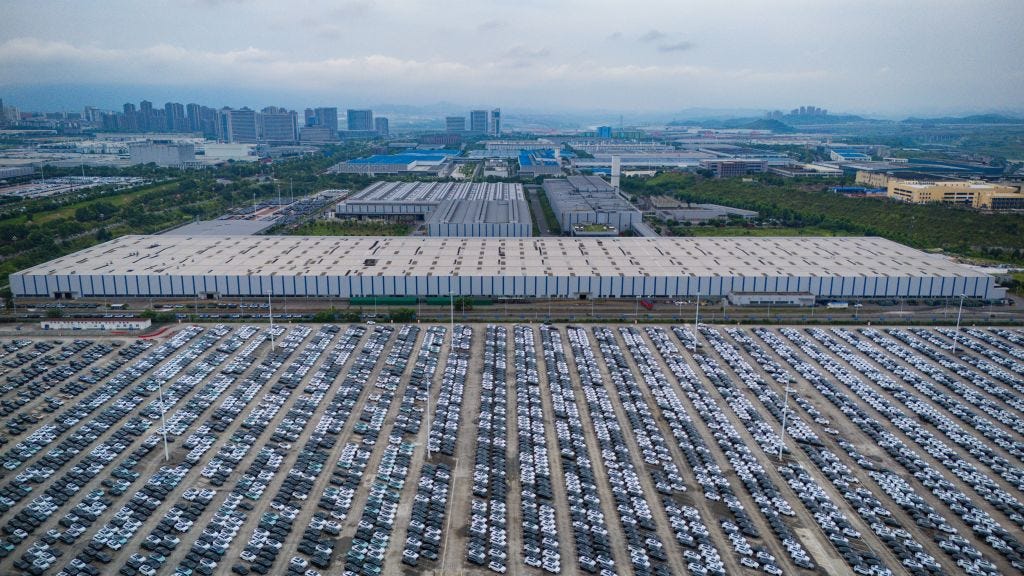EU’s countervailing duties on China’s electric vehicles show how relations have changed
New energy vehicles are being seen at Changan Automobile's vehicle distribution center in Chongqing, China, on June 16, 2024. According to the data of the China Automobile Association, from January to May 2024, the production and sales of new energy vehicles are reaching 3.926 million and 3.895 million, an increase of 30.7% and 32.5% respectively, and the market share is reaching 33.9%. (Photo by Costfoto/NurPhoto via Getty Images)
Economic relations between the European Union and China have worsened since President Xi’s visit to Paris in May 2024. European Commission President Ursula von der Leyen, during this meeting, expressed the EU’s concerns with China’s economic model. It seems that EU officials have shifted their focus from gaining market access for EU companies in China, after decades of unsuccessful attempts, to protecting the EU market from China’s massive industrial policy leading to price distortions and overcapacity.
Chinese imports to the EU skyrocketed since the COVID-19 pandemic began in 2020. Those imports were largely pandemic related items such as personal protective equipment. However, more recently and clearly more structurally, the imports include green tech for the EU’s green transition. Because of the EU’s large bilateral trade deficit with China, due to growing imports and stagnant if not falling exports, President Xi Jinping’s mantra of China’s ‘New Production Forces’ as the key engine of growth have increased the EU’s concerns about levelling the playing field for European companies. China’s economic data clearly confirms Xi’s aspirations. Industrial production has been growing much faster than consumption and exports have been increasing much more rapidly than in 2023, especially for green tech exports such as solar panels, electric vehicles (EVs), batteries for EVs and wind turbines which had long been dominated by European companies.
US President Joe Biden raised additional barriers to Chinese green tech in the months following Xi’s visit to Europe, introducing more import tariffs beyond those included in the Inflation Reduction Act (IRA). This has further discouraged Chinese imports of green tech and/or Chinese foreign direct investment in the US. China has so far not responded to these increased tariffs.
Meanwhile, the European Commission decided on 12 June to raise countervailing duties on EVs produced in China, as part of its anti-subsidy investigation at the World Trade Organization. China has paid close attention to the EU’s decision to impose duties but so far, the response has been more rhetoric than real, except for the launch of an anti-dumping probe into imported EU pork on 17 June. This is still quite limited compared to China’s threat of import tariffs being imposed on European automobiles imported into China. China and EU have reportedly started talks on the EU’s countervailing duties on EVs which are set to be applied from 4 July. However, it is unlikely that the countries will reach an agreement, or that the EU will change its mind, before the countervailing duties are imposed.
Political pressure may come from within Europe since the reaction of EU member countries to the Commission’s decision has not been as united as hoped. Germany and Sweden have expressed concerns about the measure and China’s possible future retaliation may sway more member states in that direction. Still, the positions of EU countries on this issue might be harder to determine than one thinks. For example, Germany’s Federal Minister for Economic Affairs, Robert Habeck, has offered a much harsher position on China’s economic practices, recognising that countervailing duties of EVs are just the beginning of many other actions. The EU has been using different defensive instruments, such as anti-foreign subsidy, international procurement and other types of EU-level legislation on a rage of Chinese imports, such as solar panels, wind turbines, legacy chips and more. The case against EVs produced in China is important since there are some 15 million jobs in Europe linked to this sector, but other cases will likely come.
In conclusion, the Commission appears to have changed its stance when it comes to China: rather than naïve openness, it is focusing more on economic security. Multilateralism is now being tainted by geopolitics as has been the much earlier case in other parts of the world and certainly in China. Neither China’s potential retaliation nor differences in opinion among member countries will probably be strong enough to change the direction of the Commission for two key reasons. The first is that the EU’s harsher stance is still very moderate when compared to the US and other large emerging economies like India, Turkey and Brazil. The second reason is that some European governments are turning more populist with more protectionist agendas. The jury is still out as to whether any change is to be expected from China or the EU to avoid a full-fledged trade war but, as it stands, the chances are increasingly slim.
* This is a reprint. This article has been published as part of Bruegel Zhonghua Mundus Newsletters within the EU Project China.

